Hamamelis virginiana, American witch hazel, is a native shrub or small tree that blooms in the autumn with wild looking yellow flowers.
Flowers
American witch hazel, Hamamelis virginiana, flowers grow in tight clusters of 1 to 4 at leaf axils.
The flower has 4 petals which are narrow crinkled ribbon-like, less than an inch long, and extend outward in a non-orderly manner.
Cluster of flowers: It is difficult to get a photo of a single flower with only its 4 petals.
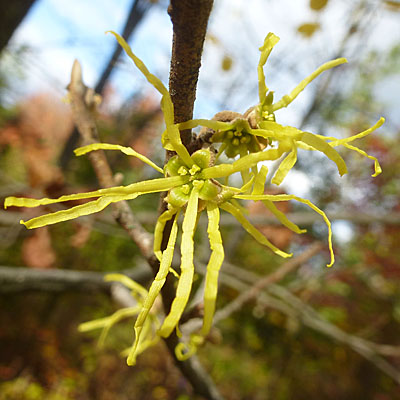
The wild array of of bright yellow petals
is a welcome when most flowers in the woods are gone.
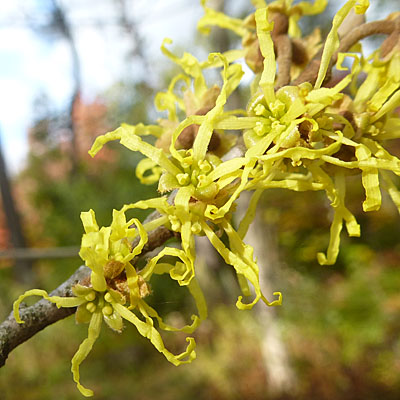
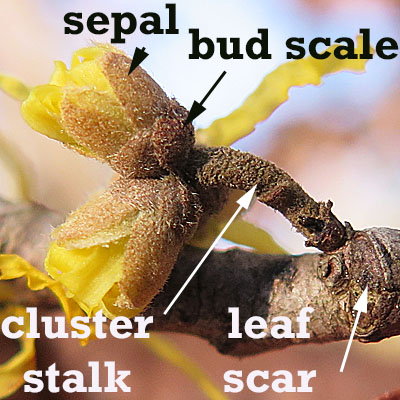
Flower buds continue to open in October through November.
In the photo to the left, are flower buds with yellow petals peeking out of the sepals and bud scales. The bud scales are the outer shorter, darker tan covering on the bud. Next, the longer light tan coverings are the sepals.
The cluster stalk which is about 1/4 inches long emerges from the edge of a leaf scar. The flowers are sessile (stalkless) on the cluster stalk
Flower petals curled up and beginning to unwind.
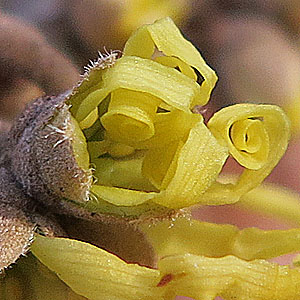
Side view: Cluster stalk, bud scales, sepals, petals.

Flower closeup: The flower has 4 petals. The flower pistil has 2 carpels, each with one ovary, one style, and one stigma. Two stigmas are easily visible. There are 4 fertile stamens and 4 nectar bearing staminodes. Also the flower has 4 sepals that are recurved (curved backwards).
The stamens are immature here.

The pollen sacs have exited the mature anthers and some are releasing pollen

This microscope photo shows the red tipped sticky surfaces of the stigmas:
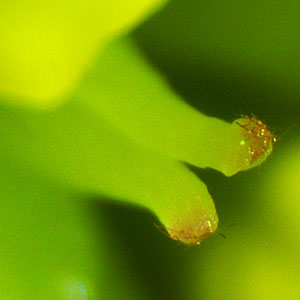
This microscope photo shows a staminode just in front of a petal. The staminodes contain nectar glands which attract insects for pollination.
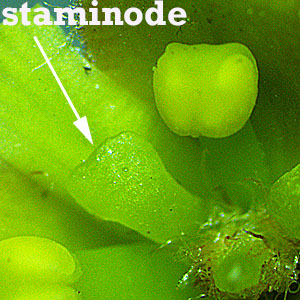
This microscope photo shows the 4 staminodes surrounding the two stigmas:

Fruit
American witch hazel has a very unusual reproduction process. Flowering and pollination occurs in the fall and then development stops and the flower overwinters dormant. Development restarts in May arround the time when the leaves start and arround that time fertilization also occurs. This delay can be as long as 7 months. After fertilization, the fruit develops reaching maturity in late August and remains on the plant even while the plant is blooming.
The calyx, sepal cup, is about 3/16 inches across. After pollination in the fall/winter the petals and stamens wither but the calyx continues through winter.
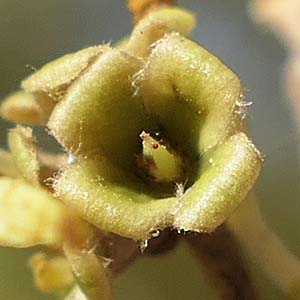
Flowers are pollinated in the fall. However, fertilization, fruit and seed development occurs the following year in the spring. June photo of developing fruit in the summer.

July photo of developing fruit.

Fruit in October: The fruit from last year's flower continues to delvelop at the same time as this year's flowers are blooming. The mature fruit is a woody brown capsule about half inch long. and contains 2 black seeds.

Fruit capsules.
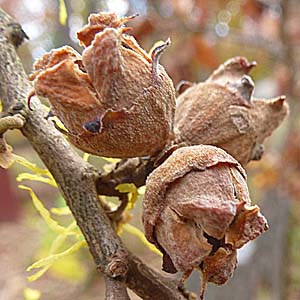
The fruit has openned and the seeds are explosively expelled up to distances of 25 feet. The seeds germinate
the second year after dispersal
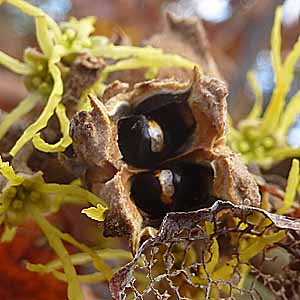
Leaves and Plant
The leaves are simple, alternate, oval shaped about 3-6 inches long with wavy edges. The base of the leaves vary from heart shaped to rounded and is asymmetrical. The leaves turn yellow in the fall. Leaf buds do not have scales.
Asymmetric leaf base: Note that in this leaf the left side extends past the right side.
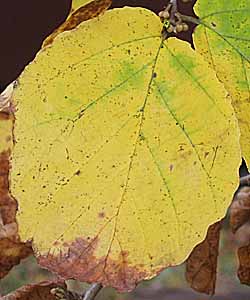
Asymmetric leaf base: Note that in this leaf the right side extends past the left side.
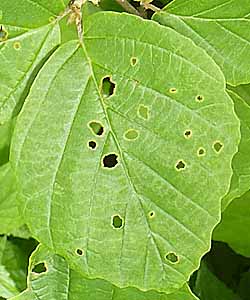
More leaves. The large right leaf clears shows asymmetry in its base.
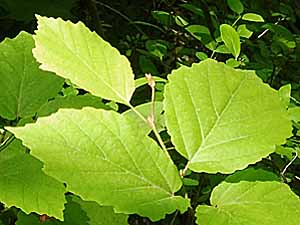
Stellate hairs. The external surfaces of the flower scales and sepals are densely covered with stellate hairs and the leaves have some also. It is easier to see that the hairs are stellar on the leaves. The microscope photo shows a stellate hair
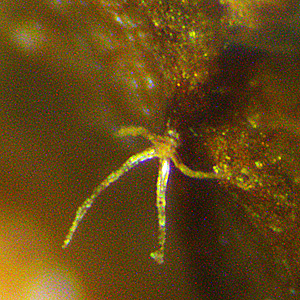
The shrub/small tree grows to be about 15-30 ft. tall is multistemed and has spreading branches.

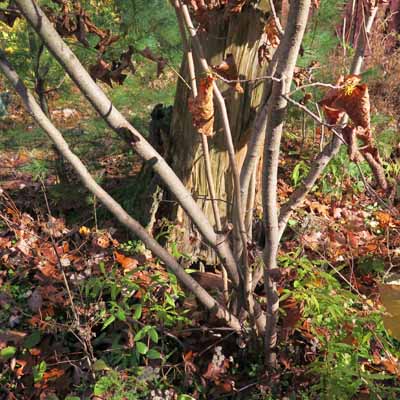
Habitat
American witch hazel, Hamamelis virginiana, grows in the forests in moist areas. We have seen it in many places, including Whittingham WMA, Black River County Park, Baldpate Mt, Sourland Mts.
Text by Millie Ling and all photos by Hubert & Millie Ling: flowers in October, fruit in summer and October, in cultivation.
Cultivation
The cultivation material below is courtesy of
Jersey Friendly Yards searchable plant database: Hamamelis virginiana
Use American Witchhazel as a specimen plant, or plant in groups for a hedge or screen. Good choice for a wildlife or woodland garden.
Deer Resistance: Some
Hardiness Zone: 6a, 6b, 7a, 7b
Salt Tolerance: Low to None
Soil Type: Loam, Organic, Sandy, Clay
Soil Moisture: Well-drained, Medium-drained
Soil pH: Acidic, Slightly Acidic, Neutral
Optimal Light: Partial Shade
Light Range: Full Sun, Partial Shade, Shade
Drought Tolerance: Low
Growth Rate: Slow-medium
Height: 20 - 30 ft
Spread: 20 - 25 ft
Additional information
Additional information / references:
Gardener News about
Mystery Native Plant
Hamamelis virginiana pollination & fertilzation information:
https://bsapubs.onlinelibrary.wiley.com/doi/pdf/10.3732/ajb.89.1.67
The USDA website shows its distribution in the US and other information,
https://plants.usda.gov/core/profile?symbol=HAVI4
Excelent gardening information: Jersey Friendly Yards
Jersey Friendly Yards searchable plant database: Hamamelis virginiana
Minnesota Wildflowers has good descriptions of the plant parts:
https://www.minnesotawildflowers.info/shrub/witch-hazel
Illinois wildflowers is also a good source of information:
https://www.illinoiswildflowers.info/trees/plants/witch_hazel.htm